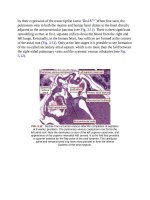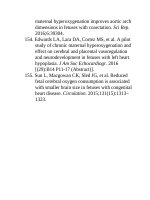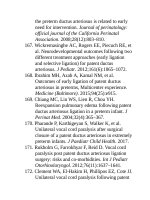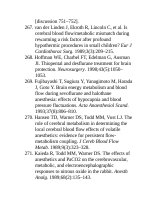Andersons pediatric cardiology 1864
Bạn đang xem bản rút gọn của tài liệu. Xem và tải ngay bản đầy đủ của tài liệu tại đây (83.7 KB, 3 trang )
measured,andifthetranspulmonarygradientisgreaterthan10mmHgandno
obstructionintheFontanpathwayisidentified,inhalednitricoxideshouldbe
considered.Ifafenestrationwasnotpartoftheoriginalprocedure,strong
considerationshouldbegiventoaddingone.Desaturationwithanormalorlow
centralvenouspressuresuggestsaright-to-leftshunt.Thismightbe
intrapulmonaryduetopreexistingpulmonarymalformations(AVMs)or,inthe
caseofalateraltunnelFontan,theright-to-leftshuntingcouldbeintracardiac
duetoabaffleleak.AlthoughpulmonaryAVMswilllikelyimprovefollowinga
completionFontan,asignificantbaffleleakwillrequireimmediaterepair.Again,
carefulevaluationwithtransesophagealechocanidentifybothbaffleobstruction
andbaffleleaksandisanessentialpartofcompletionofthesurgery.Meticulous
hemostasisisimportantasongoingtransfusionwillnegativelyimpact
hemodynamicsandlungfunction.Itisprudenttoplacechesttubesinboth
pleuralspacesaspleuraleffusionsaretherulefollowingtheFontan.Placement
oftemporarypacingwiresisessential,eveniftheinitialrhythmissatisfactory.
Arrhythmiasarecommonpostoperatively.Temporarysinusnodedysfunctionis
commonfollowingalateraltunnelFontanandisreportedwithextracardiac
Fontanaswell.
PostoperativeConsiderationsFollowingthe
FontanProcedure
Inthecurrentera,mortalityfollowingtheFontanprocedureapproaches1%.In
themostrecentSocietyofThoracicSurgeons–CongenitalHeartDisease
databasereport,themedianhospitalstayfollowingtheFontanwas14days.228In
alargerecentsingle-centerexperience,Onoandcolleaguesreportedamedian
durationofmechanicalventilationof9hours,andchesttubedurationwas4
days.286FactorsassociatedwithlongerlengthofstayintheCICUincludeda
diagnosisofhypoplasticleftheartsyndrome,anomaliesofsystemicvenous
drainage,elevatedpreoperativetranspulmonarygradient,anddecreased
preoperativearterialsaturation.IntheSingleVentricleReconstructionTrial,
whichincludedpatientswithdominantrightventricles,themortalitywasless
than1%.287Themedianhospitallengthofstaywas11daysfortheright
ventricle-to-pulmonaryarteryconduitand10daysfortheBlalock-Taussigshunt.
Riskfactorsforlongerhospitallengthincludelongerhospitallengthofstayafter
SCPCandpre-Fontancomplications.Postoperativeconsiderationsfollowingthe
FontanprocedurearesummarizedinBox71.8.
Box71.8
PostoperativeConsiderationsFollowingthe
Fontan
■Bedsidepreparedness
■Noninvasiveandinvasivemonitoring
■Bleeding
■Effectsofpositive-pressureventilationandearlyextubation
■Lowcardiacoutput
■Rhythmdisturbances
■Effusions
BedsidePreparednessandMonitoring
Theprinciplesofbedsidepreparednessaresimilartothoseoutlinedearlierand
includecommunicationwiththeoperatingroomandanesthesiateamregarding
theintraoperativecourse,bleeding,vasoactiveagents,andechocardiographic
findings.SpecificallyfollowingtheFontan,therearephysiologicbenefitsto
earlyextubation,andtheseshouldbediscussedbetweentheteaminthe
operatingroomandtheteamintheCICUtoconfirmplans,havethenecessary
equipmentavailable,andprovideclosed-loopcommunication.
EffectofPositive-PressureVentilationonthe
FontanCirculation
TheFontancirculationcanbeconsideredapreload-deficientstateresultingfrom
multiplefactors.IncontrasttotheSCPCcirculation,wherethemajorityof
systemicvenousreturndrains“directly”intothesystemicventricle,theFontan
circulationdependsprimarilyontheresidualenergyfromthesystemicblood
flowtodrivebloodbackfromthesystemicvenousreservoirstothecentral
venouscirculationandultimatelyacrossthepulmonarycirculationtoaventricle
(seeFig.71.1).WhileonPPV,elevatedITPimpedessystemicvenousreturn,
whichisworsenedduringtheinspiratoryphaseoftheventilator;multiplestudies
haveshownretrogradeflowintheinferiorcavalveinandhepaticveinsduring
thisphase.IthasbeenshownthatPPVdecreasespulmonarybloodflowand
cardiacoutput,andnegative-pressureventilation(spontaneousbreathingor
negative-pressureventilators)significantlyimprovepulmonarybloodflowand
cardiacoutput.288–295IntwoprospectivestudiesusingDoppler
echocardiographicassessmentofpulmonarybloodflowinthreepatients(mean
age,9.6years)withleftatrialisomerism/interruptedinferiorcavalveinafter
SCPCand16patients(meanage,9.9years)afteraFontanprocedure,an
increaseinpulmonarybloodflowduringspontaneousinspirationandadecrease
inpulmonarybloodflowduringexpirationorwithaValsalvamaneuverwas
observed.288,292Insummary,achievingspontaneousbreathingwithoutpositive
pressureasrapidlyaspossiblewillincreasecardiacoutputandreducecentral
venouspressure.ThisistheguidingprincipleofoptimizingtheFontan
circulation(seeChapter70).
EvaluationandManagementofLowCardiac
OutputEarlyAfterSurgery
ThesignsoflowcardiacoutputfollowingaFontanproceduremayberapidly
progressiveormoreinsidious.Theusualclinicalsignsincludetachycardia,poor
distalperfusion,decreasedurineoutput;ifprogressive,alacticacidosiswill
develop.Therearemultiplepotentialetiologiesthatcanbedividedintothree
categories,asshowninTable71.10;insomepatientstheremaybemultiple
causes.
Table71.10
DiagnosisandManagementofLowCardiacOutputFollowingthe
FontanProcedure
CVP:high
Atrialpressure:high
1.Cardiactamponade
2.FactorsincreasingatrialpressurewithnormalTPG
■Increasedend-diastolicpressure
■Systemicatrioventricularvalvestenosisand/orregurgitation
■Systemicventricularsystolicdysfunction(contractility)
■Systemicventriculardiastolicdysfunction(hypertrophy,↓preload)
3.Highmeanairwaypressure(onpositive-pressureventilation)
4.CVPmaybefurtherincreasedbyfactorsthatelevateTPG(seebelow)
CVP:high
Atrialpressure:low
1.Obstructionofanastomosesfrominferiorcavalveintopulmonaryartery
2.Hypoplasticpulmonaryarteries









